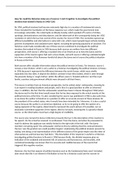How far could the historian make use of sources 1 and 2 together to investigate the political
tensions that existed in Russia in 1906? (20)
By 1906, political tensions had become extremely high due to a number of fundamental events.
These included the humiliation of the Russo-Japanese war, which made the government look
increasingly vulnerable, the catastrophe on Bloody Sunday which sparked off a series of strikes,
uprisings, demonstrations and disturbances, and the aftermath of this consequently being the 1905
revolution in which the tsar lost control of the country for most of 1905. The revolution opened up
different possibilities and alternatives to autocratic rule, which meant people began actively looking
past the incompetent and outdated tsarist regime, including the growing popularity of socialism. The
historian could make considerable use of these sources combined to investigate the political
tensions that existed in Russia in 1906 because both sources are written from two different
perspectives, with source 1 offering a rounded view of an American as to how the duma and the
supporters of the tsarist regime had such a clear divide, and with source 2 offering a detailed insight
into how a member of the Romanov family felt about the duma and of course the political situation
in Russia at the time.
Both sources offer valuable information about the political tension in Russia. For instance, source 1
reveals a clear division, which is very useful to a historian investigating the political tensions in Russia
in 1906 because it represents the difference between the social classes, which were starkly
separated into two sides. It depicts the distinct contrast in how they looked, which is seen through
the peasants being in ‘rough clothes’ whilst the officers were in ‘braided uniforms’ and the royal
family, courtiers and government officials were dressed in all their finery.
This source is written from an American perspective, by the united states’ ambassador, meaning he
is an expert in reading situations and people, and is thus in a good position to offer an informed
view. In addition, the fact that the ambassador would have been in Russia throughout 1906 (when
the duma met for the first time) would mean that he has been exposed to the actual severity of the
political tensions at the time. To add, considering the source was published in 1906 is also useful too,
as we know the author is therefore in a position to offer an accurate account of these tensions for
the president of the united states, who it would have been intended for. Moreover, it is also a useful
source because the author is an American diplomat, so he is not going to offer the opinion of a
raging opponent of the regime, determined to represent the worst picture of it possible, nor an
absolutely committed supporter of the regime, blind to its faults, meaning this is a greatly reliable
source, so the information must have a high degree of credibility.
The source also reveals the duma’s bitterness towards the tsar in the description of the reaction to
his speech. On his arrival he received ‘no enthusiasm’ from the duma, and when he proceeded to
read his address the applause was wholly limited to the right side of the hall, with ‘the duma
members remaining quiet’ the ambassador reinforces this by outlining that the contrast between
the two ‘was the greatest one could possibly imagine’ emphasizing the political tensions present by
stating ‘one being a real representation of the different classes of this great empire and the other of
what autocracy and bureaucracy had been.’ This description of the response is useful to a historian
investigating political tensions in Russia in 1906 because firstly, the divided response gives an
indication of the outdated and doomed relic of autocracy and bureaucracy, and secondly, with
contextual knowledge one knows that it is accurate and credible because of the events that
triggered this negative reaction.
However, the fact that aspects of political tensions such as the fundamental laws aren’t included,
does mean that this is an element of limitation to how far a historian could use the sources to




